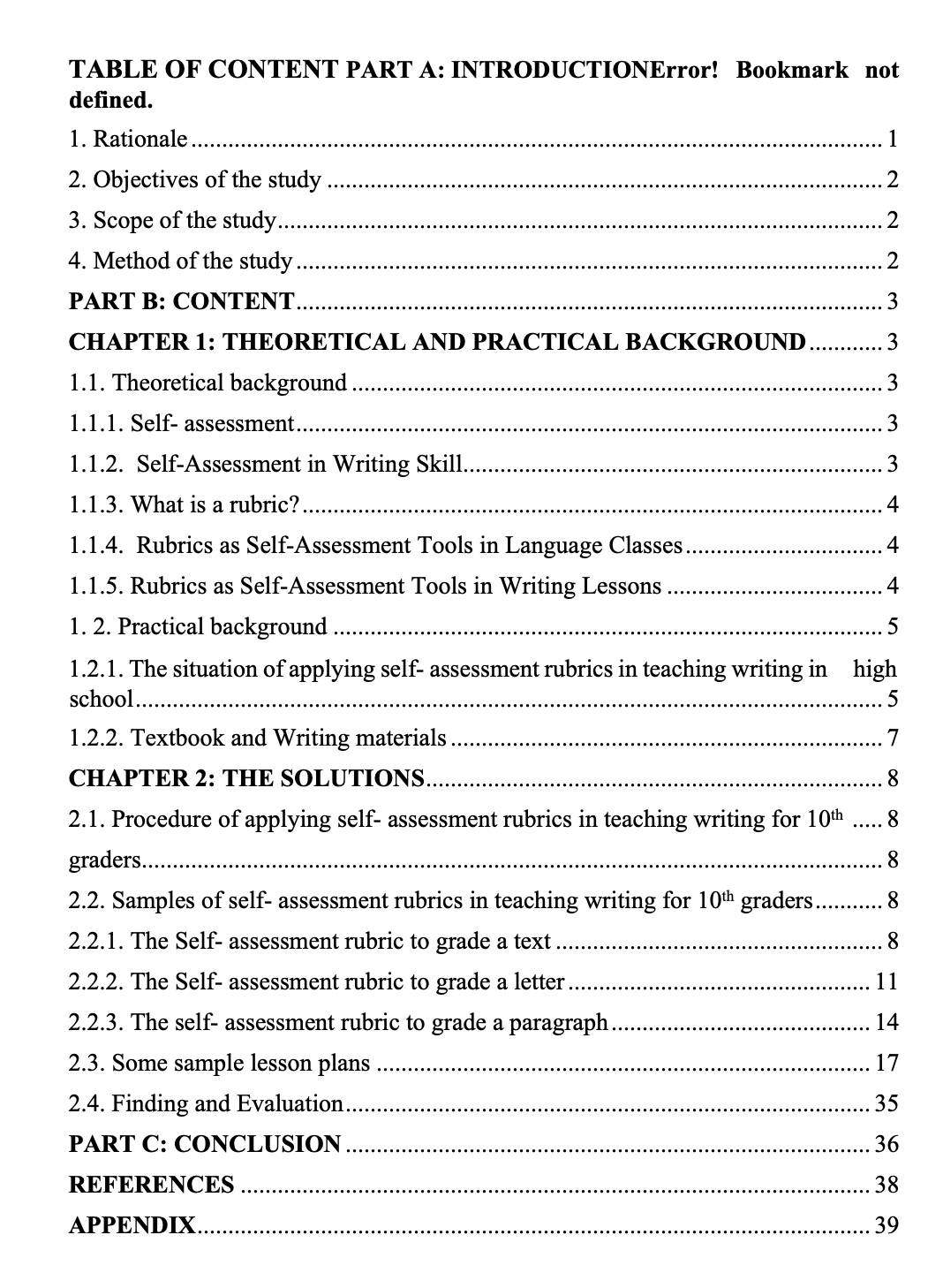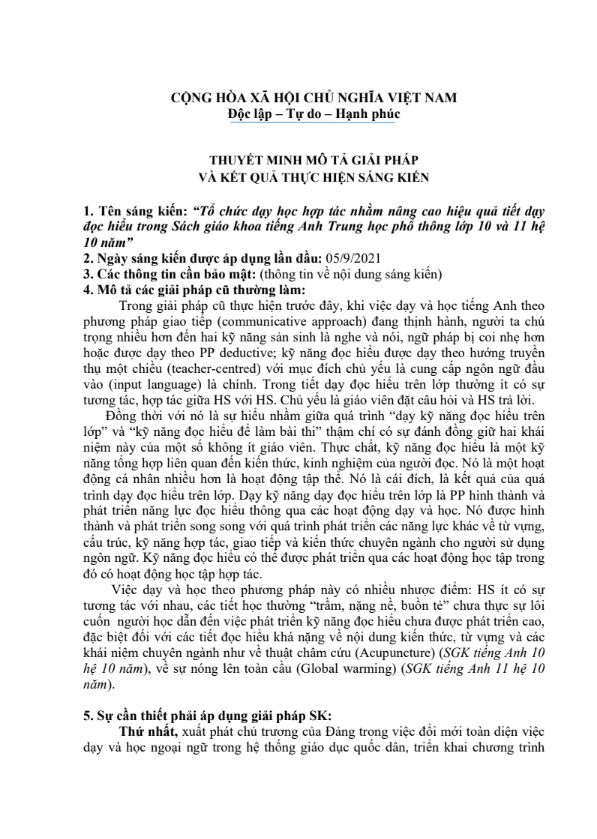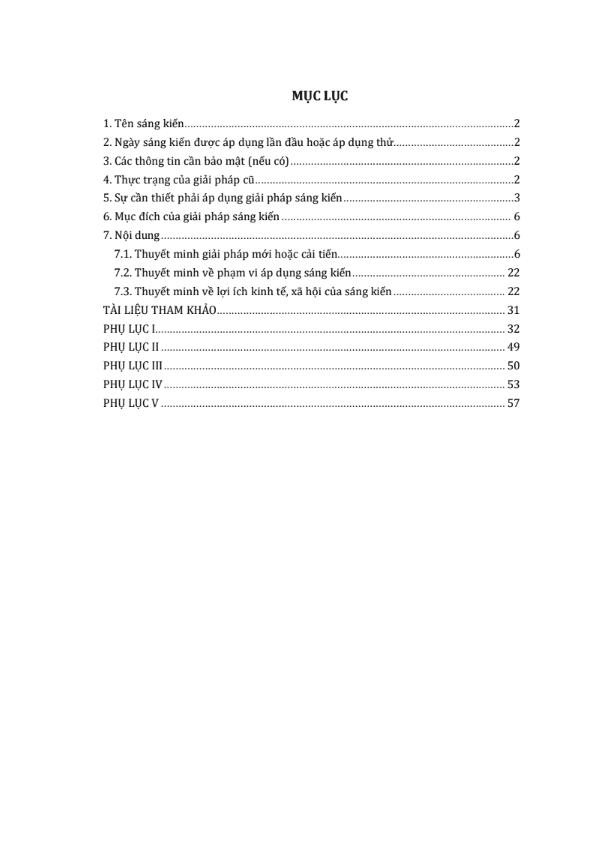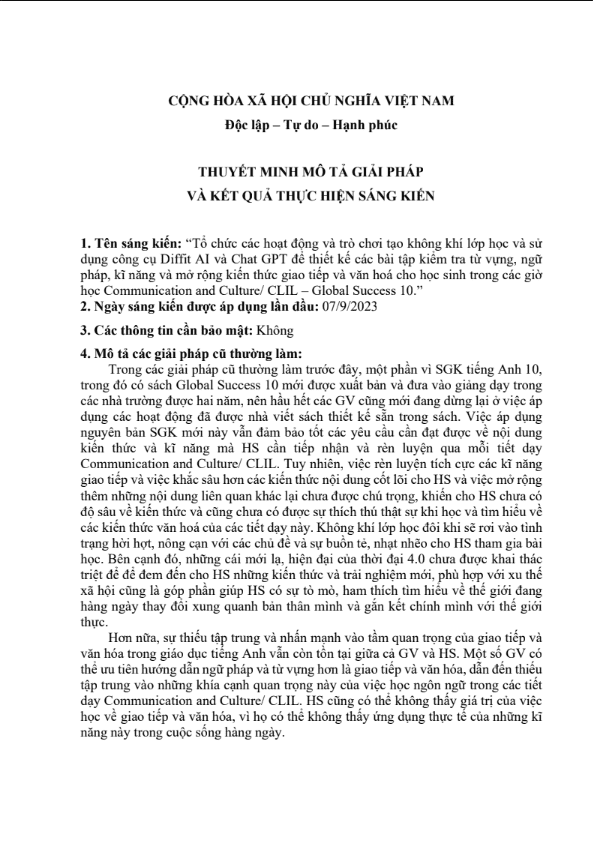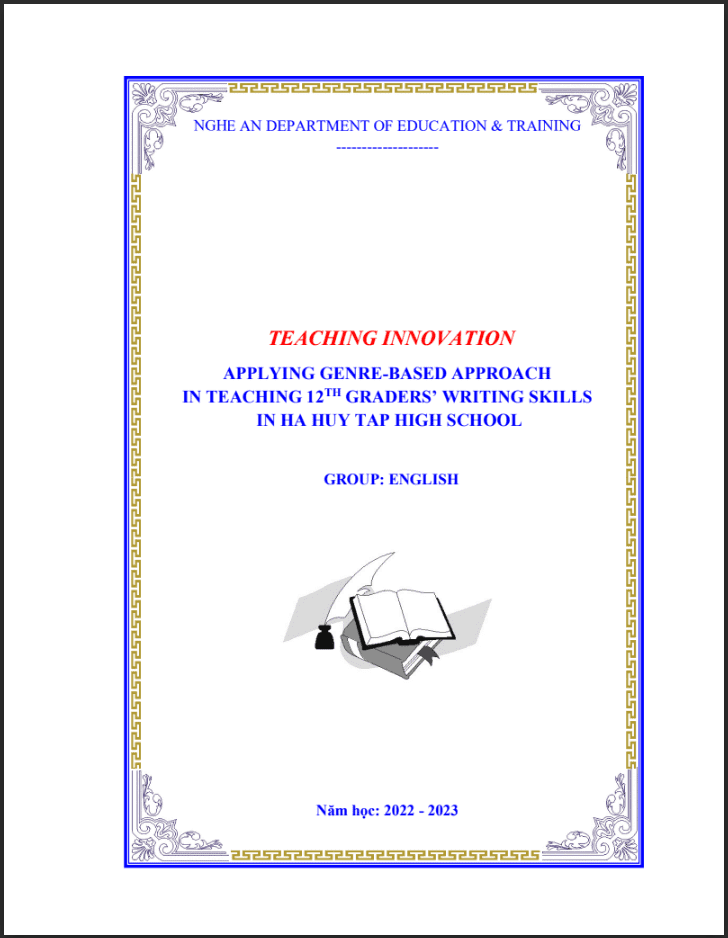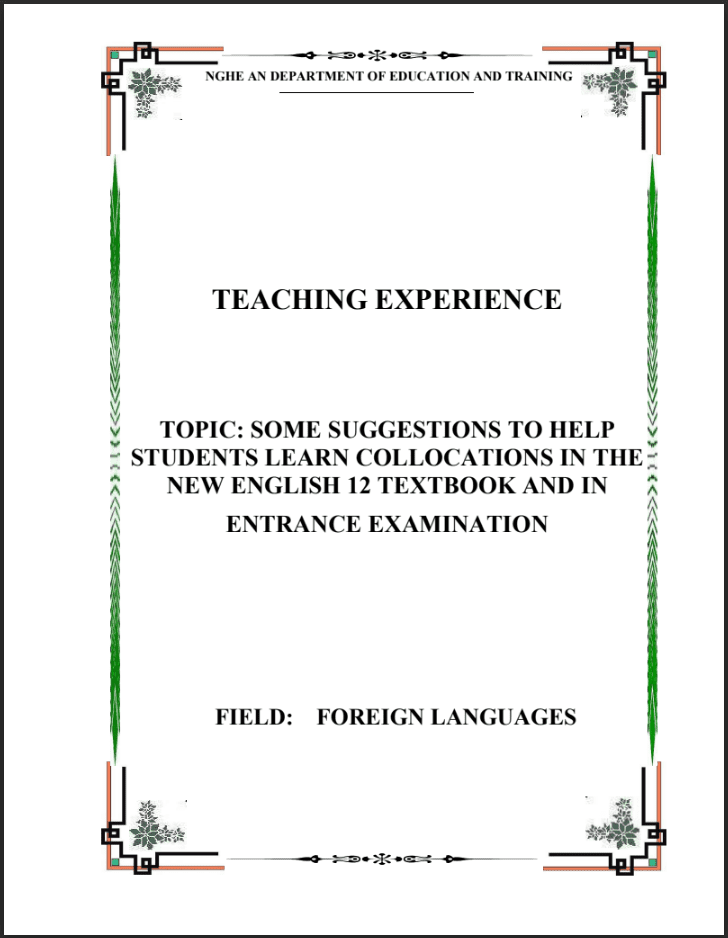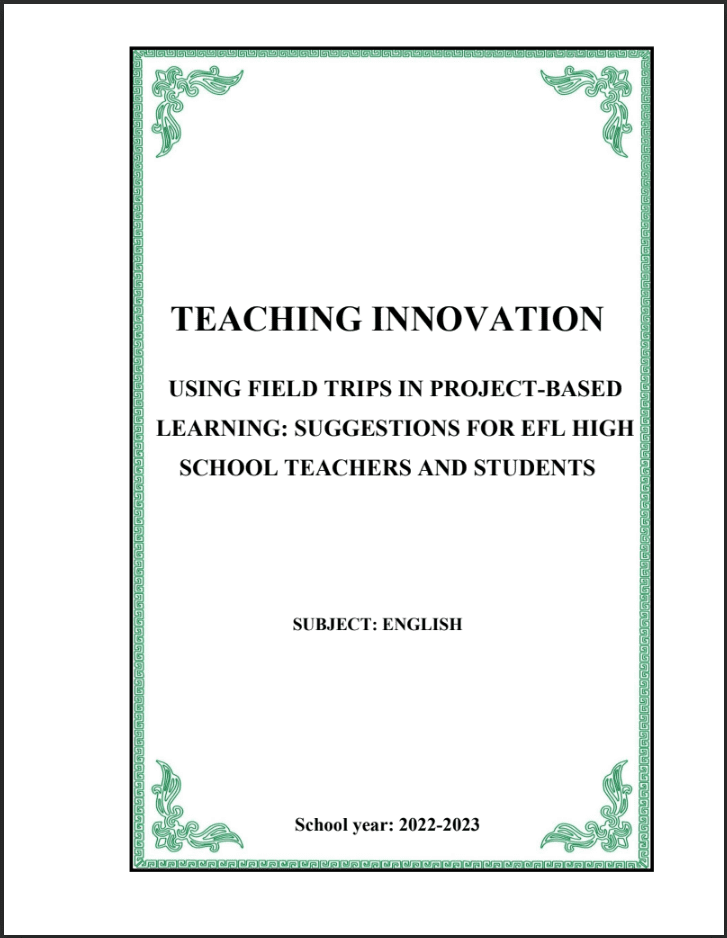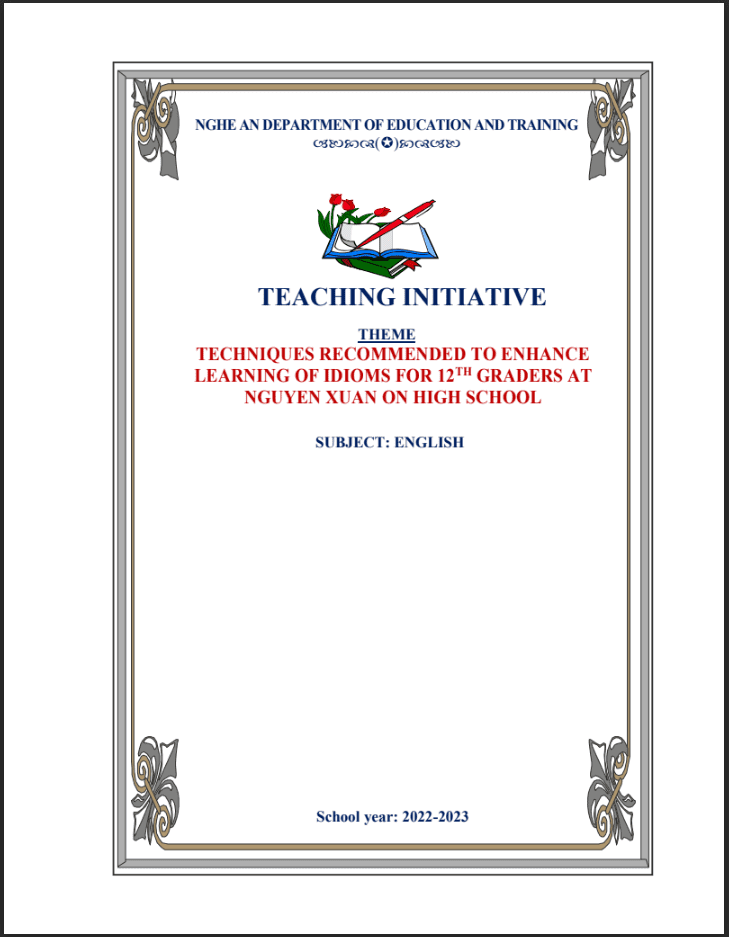SKKN Applying Self- Assessment Rubrics to Improve 10th graders‟ Writing Skill”
- Mã tài liệu: MP0007 Copy
| Môn: | Tiếng anh |
| Lớp: | 10 |
| Bộ sách: | |
| Lượt xem: | 1257 |
| Lượt tải: | 5 |
| Số trang: | 47 |
| Tác giả: | Trần Thị Mai |
| Trình độ chuyên môn: | Thạc sĩ giáo dục |
| Đơn vị công tác: | THPT Quỳnh Lưu 2 |
| Năm viết: | 2021-2022 |
| Số trang: | 47 |
| Tác giả: | Trần Thị Mai |
| Trình độ chuyên môn: | Thạc sĩ giáo dục |
| Đơn vị công tác: | THPT Quỳnh Lưu 2 |
| Năm viết: | 2021-2022 |
Sáng kiến kinh nghiệm “SKKN Applying Self- Assessment Rubrics to Improve 10th graders‟ Writing Skill”” triển khai gồm các biện pháp nổi bật sau:
– Procedure of applying self- assessment rubrics in teaching writing for 10th 8
graders
– Samples of self- assessment rubrics in teaching writing for 10th graders
– Some sample lesson plans
– Finding and Evaluation
Mô tả sản phẩm
PART A: INTRODUCTION
1. Rationale
In these days, with its worldwide popularity, English has become a core subject in the high school curriculum in Vietnam and English writing skill has emerged as an indispensable one. Nunan (2003) regards writing as a complex cognitive activity in which the writer is demanded to demonstrate control of a number of variables simultaneously at the sentence level that is made up of control of content, spelling, and letter formation and beyond the sentence structure as well as to integrate information into cohesive and coherent paragraph and text. As a result, when it comes to writing, this seems to be the toughest for EFL learners to acquire. Students encounter a variety of troubles due to their lack of background, grammar, vocabulary and the interference of the mother tongue. When getting the scored writings, they only receive a little feedback from their teachers. Upon closer reflection, I also realized that the students relied on teachers‟ comments on their work as the only source of the information for their writing skill development. In fact, most teachers have difficulty in giving students feedback not only inside but also outside of EFL classes owing to various reasons, such as the large number of students in class that makes it time – consuming for them to do so. These obstacles prevent students from achieving the targeted goal of writing skill and making a very little progress on it.
Fortunately, by self-assessing, students themselves can be excellent sources of feedback, because they could reflect on the quality of their work, judge the degree to which their work reflects explicitly stated goals or criteria, and revise their work if necessary. Self-assessment is defined as an alternative assessment where students can evaluate themselves or identify strengths and weaknesses in their own work. It is regarded as the right educational trend when realizing the goals of student-centered approach, which focuses on the process of learning and autonomous learning. Self-assessment aims at helping students to be independent learners, which is of great importance to foster lifelong language learning skills (Oscarson, 2009). That is one of the prominent general competencies in the General Education Program 2018 of MOET.
In fact, during the past decade, movements towards learner-centered language instruction as well as a renewed interest in the authenticity, interactive pedagogy, and the general impact of language assessments have progressively come together to create an increased awareness in expanding the role of the learner and test-taker in the teaching and learning process (Bachman, 2000). Self – assessment with the use of rubrics which has been growing in popularity in EFL classroom is proved to be an ultimate tool in students „writing skill. Rubrics are often used to evaluate students‟ work but they can also teach. When utilized as part of a formative and student-centered assessment, analytic rubrics have the potential to facilitate learners to develop a “vision of success” as well as “make dependable judgments about the quality of their own work” (Stiggins, 2001). In addition, it also helps students to identify strengths and weaknesses and learning needs (Johnson, Penny, & Gordon, 2000). By asking students to do self – assessment, it is found that they become more interested in writing. The students have opportunity to actively participate in assessing themselves, thus, their attitudes toward evaluation become more positive as well as they became more confident about their ability. Therefore, it stands to reasons that rubrics can bring a variety of merits for English language learners.
Having been a high school teacher of English for nine years, I have been aware of the hurdles students and teachers face when it comes to writing skill. Especially, during a school year which has been greatly influenced by Covid – 19 pandemics. Flexible teaching and learning modalities have been implemented. Most of the academic year, we had to teach online, which leaded to the increasing number of difficulties. Those issues have inspired me to conduct the experience initiative entitled “Applying Self- Assessment Rubrics to Improve 10th graders‟ Writing Skill” with a view of improving students‟ writing performance. To be honest, there are inevitable shortcomings and mistakes in my study in such limited time. I am, therefore, glad to receive constructive comments from my colleagues so that it will be more perfect and applicable.
2. Objectives of the study
The present study aims to :
- investigate the situation of applying self-assessment rubrics in writing skill in Quynh Luu 2 high school.
- help improve students‟ writing production by self-evaluating with the use of rubrics
3. Scope of the study
The study is limited to 2 classes with 80 students of grade 10 at Quynh Luu 2 high school. One class (10A2) is the experimental class utilizing rubrics for selfassessment in writing lesson. The other (10D6) is the control one taught by the conventional method.
4. Method of the study
This study consists of qualitative and quantitative method. The data collected is from a pretest-posttest design, a questionnaire conducted by EFL high school students and teachers at Quynh Luu 2 high school. Besides, observation is also employed.
PART B: CONTENT
CHAPTER 1: THEORETICAL AND PRACTICAL BACKGROUND
1.1. Theoretical background
1.1.1. Self- assessment
Self-assessment is defined as a process of formative evaluation during which students reflect on the quality of their work, judge the degree to which it reflects explicitly stated goals or criteria, and revise accordingly. To foster learning is the prominent goal of this type of assessment because it gives timely feedback on pupils‟ comprehension and performance (Andrade & Cizek, 2010).
It can be said that Self-assessment is an assessment where students can assess their self or identify strengths and weaknesses in their own work. It is also to realize the goals of student-centered learning. Self-assessment aims to help students to be independent learners. Self-assessment is considered important to the development of lifelong language learning skills and the development of more comprehensive assessment practices.
1.1.2. Self-Assessment in Writing Skill
Self-assessment as a formative assessment process starts when the quality of work and learning are reflected and evaluated, followed by the judgment of reflection degree based on goals or criteria, as well as identifies strengths and weaknesses of writing before making revision if necessary. Self – assessment can be used to effectively plan the writing outline and validate their arguments through the provided evidence by realizing the weaknesses of their writing in terms of missing or lacking elements . Iraji, Enayat, and Momeni (2016) also claimed that self-assessment can be used as a learning tool to lower anxiety of students and improve their writing skills.
A number of theorists (e.g. Farr and Tone, 1994; O’Malley and Pierce, 1996; Thomas & Barksdale-Ladd, 2000) have all argued that self-assessment can be an effective means of improving students‟ writing. These authors contend that selfassessment promotes self-reflection, self-esteem and self-confidence which ultimately improve students‟ writing (El-Koumy, 2004). Other practitioners (e.g. Andrade & Du, 2005; Cunningham and Cunningham, 1987; Kirszner and Mandell, 1989; Lebauer and Scarcella, 1992; Radecki and Swales, 1988; Ross et al., 1999) have expanded upon this research and have demonstrated that students can actually play a key role in assessing the final product of their writing. They claim that this type of self-assessment helps students to master English writing conventions which can, in turn, enhance their writing. They also claim that self-assessing the outcomes of writing helps students to evaluate the degree of attainment of the writing-program goals.
TÀI LIỆU LIÊN QUAN
- 7
- 105
- 1
- [product_views]
- 5
- 173
- 2
- [product_views]
- 4
- 165
- 3
- [product_views]
- 4
- 129
- 4
- [product_views]
100.000 ₫
- 6
- 434
- 5
- [product_views]
100.000 ₫
- 2
- 507
- 6
- [product_views]
100.000 ₫
- 9
- 546
- 7
- [product_views]
100.000 ₫
- 4
- 409
- 8
- [product_views]
100.000 ₫
- 2
- 595
- 9
- [product_views]
100.000 ₫
- 0
- 538
- 10
- [product_views]

